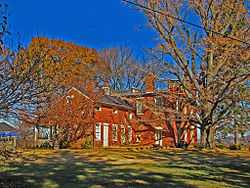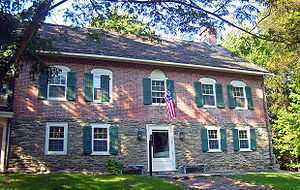Dard Hunter
William Joseph "Dard" Hunter (November 29, 1883 – February 20, 1966) was an American authority on printing, paper, and papermaking, especially by hand, using the tools and craft of four centuries prior. Hunter produced two hundred copies of his book Old Papermaking, preparing every aspect of the book himself: he wrote the text, designed and cast the type, did the typesetting, handmade the paper, and printed and bound the book. A display at the Smithsonian Institution that appeared with his work read, "In the entire history of printing, these are the first books to have been made in their entirety by the labors of one man."[1] He also wrote Papermarking by Hand in America (1950), a similar but larger undertaking.
Active in the Arts and Crafts movement, Hunter created and championed many other types of handmade arts and crafts, publishing his own guides, such as Things You Can Make. He experimented with pottery, jewelry, stained glass windows, and furniture. He also founded a correspondence school, the Dard Hunter School of Handicrafts.
Biography

Hunter was born and raised in Steubenville, Ohio, where his father published a gazette and ran a printery. From 1900 to 1903 he attended Ohio State University. He began his career in East Aurora, New York with a job at Roycroft, the Arts and Crafts company of Elbert Hubbard. In 1908, Dard married Edith Cornell, a pianist he met at Roycroft, and the couple honeymooned in Vienna, a location inspired by Hunter's interest in Josef Hoffmann. Hunter returned to Europe to study papermaking in Italy, and was graduated from Vienna's Royal-Imperial Graphic Teaching and Experimental Institute (K. K. Graphische Lehr und Versuchsanstalt).
The couple went to London in 1911, where he worked as a commercial designer with Norfolk Studios. An exhibit at the London Science Museum provoked his interest in papermaking. In his exploration of primitive and early papermaking (a craft with origins in China about 105 AD), he would travel to East Asia and Pacific locales such as Samoa, Tonga, and Fiji.

In 1912, they returned to the United States, and Hunter bought and moved into the Gomez Mill House near Marlboro, New York. He built a small papermill there, and crafted his first books on papermaking. Handmade paper was not being produced in America at the time; it had to be purchased from Europe. His English papermaking appliances were three centuries old, and were operated by a wooden water wheel. Over forty-six years, he wrote twenty books about papermaking, eight of which were hand-printed.[2]
In 1919, the Hunter family returned to Ohio and purchased the 1852 "Mountain House" in Chillicothe, which had been built for German winemakers.[3] Hunter used a wing joined to the house for his letterpress printing studio, named Mountain House Press, where he produced eight handmade books, authored twenty books on the topic of papermaking, and was an active publisher between 1922 and 1956. In 1958 he published his autobiography, My Life with Paper.
Hunter opened the Dard Hunter Paper Museum at the Massachusetts Institute of Technology in 1939, which he considered his greatest accomplishment.[2] It was moved to the Institute of Paper Chemistry in Appleton, Wisconsin in 1954. The Robert C. Williams Paper Museum now comprises most of the collection of the Institute of Paper Science and Technology, on the campus of the Georgia Institute of Technology in Atlanta.
Hunter died in 1966 at Chillicothe, survived by two sons. His wife had died in 1951. Members of his family maintain Dard Hunter Studios at the historic Mountain House, which are open to the public by appointment. The studio provides an online library.[4]
Hunter is buried in Grandview Cemetery, Chillicothe, Ross County, Ohio, USA.
Legacy
In addition to books written during his lifetime, Dard Hunter & Son is a tribute to the work of Hunter. The 1998 book was selected and exhibited in the New York Public Library's 2003–2004 exhibition Ninety from the Nineties.[5]
To promote and continue the tradition of hand papermaking and book arts, Friends of Dard Hunter was established in 1981.
References
- ↑ "Dard Hunter, 82, an Authority on Paper and Printing, Is Dead". New York Times. 1966-02-22. p. 21.
- ↑ 2.0 2.1 "The Life of Dard Hunter". Dard Hunter Studios. Retrieved 2007-01-12.
- ↑ Owen, Lorrie K., ed. Dictionary of Ohio Historic Places. Vol. 2. St. Clair Shores: Somerset, 1999, 1222.
- ↑ resources provided by Dard Hunter Studios.
- ↑ Ninety from the Nineties: A Decade of Printing. (Catalogue of the exhibition at The New York Public Library.) Text by Virginia Bartow, curator, 2003.
Further reading
| Wikimedia Commons has media related to Dard Hunter. |
- "Paper maker's ancient art to be shown to New York; Dard Hunter will use utensils and methods in vogue four centuries ago — his mill at Marlboro-on-Hudson is operated by a wooden water wheel". New York Times. 1924-04-06. p. XX15.
- Winterich, John (1958). Pages That Tell a Story: My Life with Paper: An Autobiography. New York: Alfred A. Knopf. p. 236.
- Hunter, Dard (1978) [1st. pub. Alfred A. Knopf:1947]. Papermaking: The History and Technique of an Ancient Craft. New York: Dover Publications. ISBN 0-486-23619-6.
- Baker, Cathleen A. (2000). By His Own Labor: The Biography of Dard Hunter. New Castle, Del.: Oak Knoll Press. ISBN 1-58456-020-7.
- Hunter II, Dard; Hunter III, Dard (1998). Dard Hunter & Son. Newton, Pa.: Bird & Bull Press.
External links
- Elbert Hubbard, Dard Hunter and the Roycroft Workshops
- Dard Hunter Studios
- Friends of Dard Hunter, a non-profit organization
- Dard Hunter at Find a Grave
- The Harrison Elliott Collection at the Library of Congress has the sample collection of 300 early American papers and the correspondence and memorabilia of Dard Hunter, an authority on the history of paper.
|